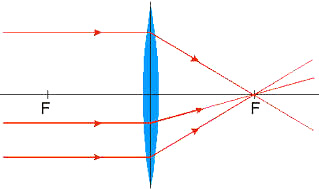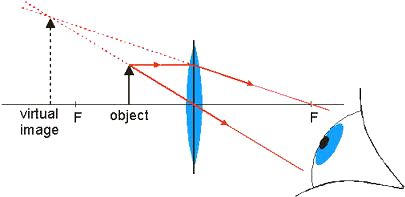The lenses used in cameras, projectors, and even your eyes are called convex lenses. These lenses are shaped in a way so that they focus incoming parallel rays of light to a point as shown below.

When light hits an object it is usually coming from all different directions so it bounces off in all different directions. That means light from an object will hit a lens from many different directions as shown below.

These rays of light will bend in predictable patterns after passing through the lens. We can use this fact to figure out where the image will be formed.
There are three rays of light we will
use to predict where the image
will end up. They are:
Ray1: Light that travels into a convex lens parallel to the principle axis refracts out through the back F.
Ray 2: Light that travels in from front F refracts out parallel to the principle axis.
Ray 3: Light that travels into the center of the lens does not bend.
Ray1: Light that travels into a convex lens parallel to the principle axis refracts out through the back F.
Ray 2: Light that travels in from front F refracts out parallel to the principle axis.
Ray 3: Light that travels into the center of the lens does not bend.

The point at which the outgoing rays of light meet is where the point where the image is formed by the lens. The fact that these rays of light meet at the same point mean that they will form a real image. A real image can be projected onto a screen, captured on a piece of film in a camera, or projected onto your retina in your eye. This is the reason that all devices that require these jobs to be done also require a convex lens. This type of image is called a real image.
It is possible using a convex lens to produce an image that can not be projected onto a screen. This type of image is called a virtual image. This happens when an object is brought to close to the lens and inside the focal length. This is shown below.

Notice that the outgoing rays of light will never meet. This means that the image will "appear" to be on the same side as the object. The image is found by tracing the outgoing rays of light behind the lens until they meet. Notice that the image is much larger than the original object. This means that convex lenses can be used to make objects appear larger as long as they are very close to the lens and the person is viewing the object through the lens. This is how we make "magnifying glasses". Notice though that the image does not really exist. This is why cameras can not take pictures of objects if they are too close to the lens. This type of image is called a virtual image.
Please note that we used the same lines to find the image, and that only two rays are needed to find the image since all rays will intersect at the same point regardless which side of the lens they will meet on.
Return to Previous Page